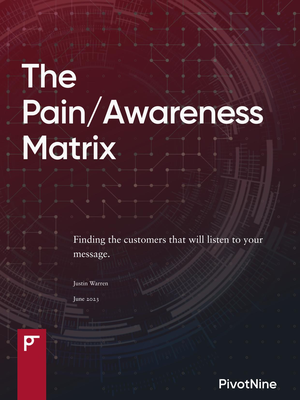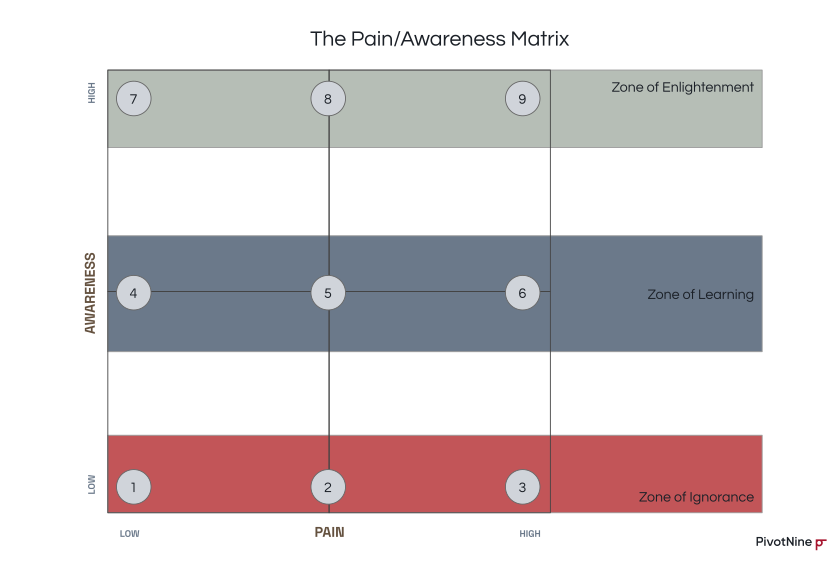The Pain/Awareness Matrix

The Pain/Awareness Matrix
Customers are busy.
Busy customers that aren't in pain don't need help. If you try to help them anyway, the customer will likely get annoyed. They have other things to do.
While it's possible that your product or service could help the customer, vendors often have an inflated opinion of themselves and their products. A mismatch between what a vendor thinks a customer needs and what the customer thinks they need leads to friction. Customers think the vendor is wasting their time. Vendors are frustrated that the customer doesn't understand the value of what they're offering.
Rather than trying to sell harder to customers that don't need your product, why not seek out customers that do?
To figure out which customers to talk to, vendors need to spend time on research. Specifically, they need to research customer problem awareness, and customer pain. The Pain/Awareness matrix can help guide this research.

Researching Problem Awareness
Researching problem awareness will help to determine if the lack of adoption of solutions is due to not knowing the problem exists (to some level of detail) or if the audience is well aware of the problem but not aware of appropriate solutions to the problem.
Answering this question will help identify where marketing effort should be spent: on raising awareness of the problem more generally, or marketing specifically as a solution to the known problem.
If you're unable to find any customers that have the problem your product solves, then there is no market for what you're selling. You either need to create a market for your product with very clever marketing (a fiendishly difficult task) or you should change your product to appeal to a problem real customers actually have.
It is far more likely that there are customers that do indeed have the problem you solve, but they've never heard of you. Why spend your time arguing with customers that don't need your product when you could be helping the customers that do need you to discover that you exist?
The Three Zones
Customer awareness of their pain and the potential solutions generally falls into three broad categories:
- The Zone of Ignorance
- The Zone of Learning
- The Zone of Enlightenment
The Zone of Ignorance
- This problem doesn't affect me, and I don't even know it exists.
- I'm in a bit of pain but have no idea why. It might not be this problem.
- I am currently in a lot of pain, but I don't know why. I might think it's this problem, but I'm wrong and it's actually something else.
The Zone of Learning
- I know of the problem, but I don't have the problem myself.
- I'm aware of the problem, and it affects me somewhat. I have bigger problems, but I'm trying to learn more about it so that the problem doesn't get worse.
- I am currently in a lot of pain, and have some clues that it might be this problem, but it could be something else. I'm actively working to try to figure it out.
The Zone of Enlightenment
- I am well aware of the problem, in detail, and have determined that it is not currently a problem for me. I also know the circumstances that would lead it to becoming a problem for me.
- I am well aware of the problem as it currently affects me. I can describe the pain it is causing me and I'm working on fixing it, but it's not my top priority.
- I am well aware of the problem as it currently affects me, and it is causing a lot of pain. I am actively looking for solutions.
Identifying the clarifying questions to ask prospects so that they can be categorised will allow you to quickly identify the customers most in need that will be the most easily convinced of your product's value. This research will also provide indicators of the current market opportunity and its likely growth rate, which can be used for future research and product development.
Once you have an idea of the kinds of customers that exist, you need to decide which ones to focus your time on. As we discussed above, why spend your time annoying customers that don't need or want you when there are other customers crying out for help that don't even know you exist?
The Best Prospects
The best prospects are found in categories 3, 5, 6, 8, and 9.
Category 3
Prospects in category 3 are in substantial pain, which means removing that pain is of high value to them. They are unaware of the cause of their pain, however, which can provide opportunity, but also danger.
Some prospects in category 3 believe they have identified a possible cause of their pain but are wrong. If this belief is firmly held, you will be unable to convince them your solution is the correct one without substantial effort, and it is generally unwise to start off by arguing with a potential customer about how wrong they are. It's also possible that prospects are in category 3 because you are wrong about the nature of the cause of pain and your proposed solution won't work.
You will need to spend time educating customers in category 3 but they should be good prospects if you succeed.
Category 5 and 6
Prospects in categories 5 and 6 have medium awareness, which indicates at least some understanding of the problem domain and a demonstrated ability to learn more about it.
They are also in enough pain to be sufficiently motivated to seek out a solution and are therefore likely to be receptive to your marketing efforts.
Prospects in category 3 should move into category 5 or 6 as you educate them about the problem and your solution to it.
Category 8 and 9
Prospects in categories 8 and 9 are well aware of their problem and potential solutions if not their exact form, yet they are still in substantial pain which means they have not yet managed to solve their problem.
Assuming your product is a good solution to their problem, why haven't these prospects bought from you already? The most likely reason is that they simply don't know you exist. If they do know you exist, then you're probably not explaining what your product does very well.
Prospects in categories 8 and 9 should be the easiest to convert into customers. They also tend to make the best case studies because the benefits they'll receive are the most substantial. Try to capture as much information as you can about this 'before' picture so that you can compare and contrast it to the 'after' picture you plan to show them.
There is one major risk here though: A competitor may already be talking to these prospects already. They may already be well down the path to a solution and about to move into category 4 or 7. You will need to assess each situation to see if it's worth the effort of trying to win the customer or if you're better off moving on to other, less competitive deals.
Prospects to Avoid
Avoid prospects in categories 1, 2, 4, and 7 until you've spent time focusing on the best prospects discussed above.
Category 1
Prospects in category 1 aren't in pain and don't care about your product.
Even if you think these customers really do need your product, they will be very hard to convince. Time spent arguing with these customers is time and effort that could be spent finding and helping customers that really need you.
It's helpful for these customers to know you exist, just in case they or something they know ever does need your product. Other than that, customers in category 1 are best left alone.
Category 2
Prospects in category 2 aren't ready to buy yet.
They need to be moved into category 3 or 5 first. Either the problem needs to get worse for them first, or they need to learn more about it before they're worth engaging with actively.
Category 4
Prospects in category 4 aren't in pain, just like those in category 1. They are better informed than prospects in category 1 so are even harder to convince that they might need your product.
Once again, other than knowing that you exist, prospects in category 4 are best left alone until their situation changes.
Category 7
Prospects in category 7 have generally just solved this problem and so are no longer in pain.
They are also well informed about the nature of the problem, at least so much as it used to affect them. You may be able to learn something from category 7 people about how they chose the solution that has worked for them. This might help you convince other prospects to choose you in future. However, it's not worth investing substantial effort trying to sell to prospects in category 7 because they do not need to buy from you.
If their problem recurs because their chosen solution turns out not to work as well as hoped (thus indicating less-than-perfect information about the nature of their problem) they may turn into solid prospects again, so it's worth keeping on friendly terms with them provided it doesn't require much effort.


